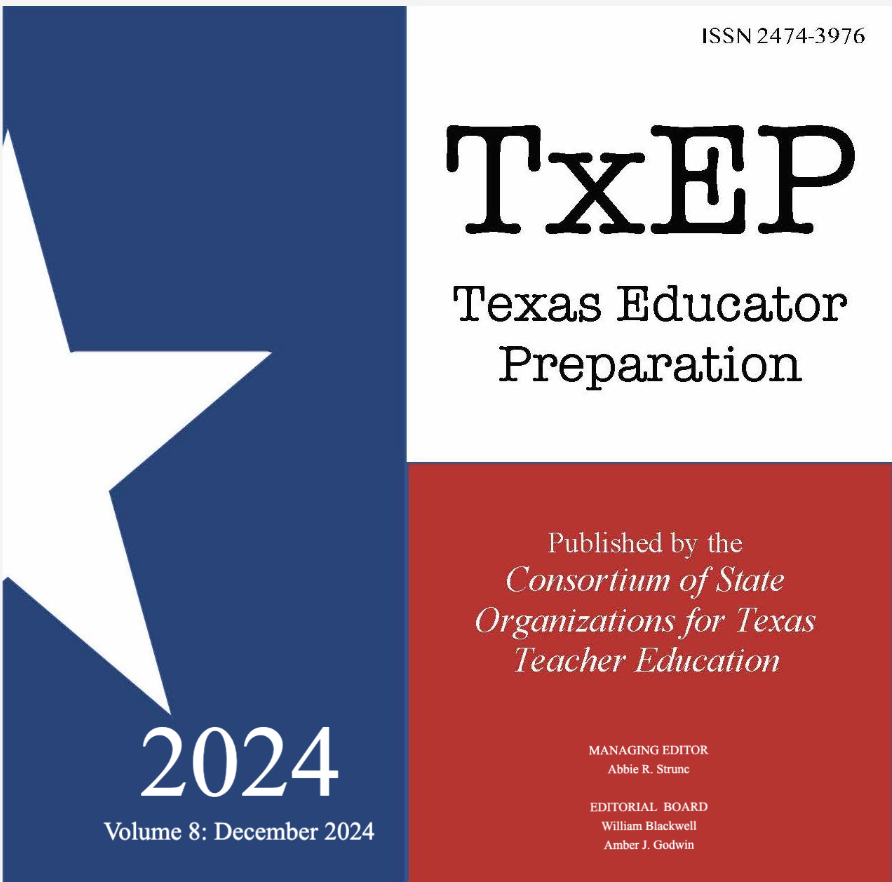All Means All: Correlates for Success on a Social Studies Licensure Exam
DOI:
https://doi.org/10.59719/txep.v8i1.49Keywords:
Social Studies, Teacher Preparation, Barriers, Licensure ExamsAbstract
The social studies subtest on the TExES 391 teacher licensure exam consistently causes failure among preservice teachers from a regional university. Failing one section of the exam is enough to be a barrier to achieving teacher certification. To understand potential influences on success, eighty-five exam scores were examined in correlation to academic history, program location, and basic demographic information. The results point to variables that may be useful to identify students for potential intervention. They also highlight the need for more in-depth exploration of student struggles to facilitate the intentional construction of effective supports.
Downloads
References
Baker-Doyle, K. J., & Petchauer, E. (2015). Rumor has it: Investigating teacher licensure exam advice networks. Teacher Education Quarterly, 42(3), 3-32.
Darling-Hammond, L., Holtzman, D. J., Gatlin, S. J., & Heilig, J. V. (2005). Does teacher preparation matter? Evidence about teacher certification, Teach for America, and teacher effectiveness. Education Policy Analysis Archives, 13(42), n42.
Ding, M. (2016). Developing preservice elementary teachers’ specialized content knowledge: the case of associative property. International Journal of STEM Education, 3(1), 1-19. https://doi.org/10.1186/s40594-016-0041-4
Feuer, M. J., Floden, R. E., Chudowsky, N., & Ahn, J. (2013). Evaluation of Teacher Preparation Programs: Purposes, Methods, and Policy Options. National Academy of Education. 500 Fifth Street NW Suite 339, Washington, DC 20001.
Gitomer, D. H., Brown, T. L., & Bonett, J. (2011). Useful signal or unnecessary obstacle? The role of basic skills tests in teacher preparation. Journal of Teacher Education, 62(5), 431-445.
Harrell, P. E., Subramaniam, K., Long, C., Thompson, R., & Pope, E. (2023). Increasing Hispanics in the educator workforce: A science methods intervention to improve passing rates on an EC-6 science certification examination. Journal of Latinos and Education, 22(4), 1612–1621. https://doi.org/10.1080/15348431.2021.2022486
Hughes, C., Diego-Medrano, E., & Nix, S. (2016). An investigation of elementary teacher candidates’ pedagogical and content knowledge of the social studies curriculum. Journal of Social Studies and History Education, 1(2). 1-11.
Jehi, T., Mulvey, M., Shulgan, E., Burke, E., Dean, M., Betancourt, J., Carliss, G., Khan, R., Majzoub, N., Halawani, R., Beeson, L., & Zeman, C. (2024). Anxiety, depression, stress, and test anxiety are inversely associated with academic performance among undergraduate students post-COVID-19 confinement. American Journal of Health Education, 55(2), 89–99. https://doi.org/10.1080/19325037.2023.2296943
Jones, J., McDonald, C., Maddox, A., & McDonald, S. (2011). Teacher candidate success on state mandated professional tests: one predictive measure. Education (Chula Vista), 131(4), 905-921.
Killion, L. & Varela, D. (2021). Contributing factors for passing high-stakes exams. The Texas Forum of Teacher Education, 11, 92-98.
Long, C. S., Harrell, P., Subramaniam, K., Pope, E., & Thompson, R. (2023). Strengthening elementary preservice teachers’ physical science content knowledge: A 3-Year Study. Research in Science Education (Australasian Science Education Research Association), 53(3), 613–632. https://doi.org/10.1007/s11165-022-10071-9
MacDonald, K. (2018). A review of the literature: The needs of nontraditional students in postsecondary education. Strategic Enrollment Management Quarterly, 5(4), 159–164. https://doi.org/10.1002/sem3.20115
Maddox, A., & Reglin, G. (2019). Teacher preparation tests and grade point average as a predictor of teacher licensure high-stakes tests. College Student Journal, 53(2), 229–242.
Tex. Admin. Code § 229.4 (2024) Retrieved April 1, 2024 from https://texreg.sos.state.tx.us/public/readtac$ext.TacPage?sl=R&app=9&p_dir=&p_rloc=&p_tloc=&p_ploc=&pg=1&p_tac=&ti=19&pt=7&ch=229&rl=4
Tex. Admin. Code Figure § 230.21(e) (2024) Retrieved April 3, 2024 from https://texreg.sos.state.tx.us/fids/202003979-2.pdf
Pearson Education, Inc., (2024a). Core Subjects EC-6. Texas Educator Certification Examination Program. Retrieved April 2, 2024, from https://www.tx.nesinc.com/TestView.aspx?f=HTML_FRAG/TX391_TestPage.html
Pearson Education, Inc., (2024b). Retake Policy. Texas Educator Certification Examination Program. Retrieved April 3, 2024, from https://www.tx.nesinc.com/pageView.aspx?f=Gen_retakepolicy.html
Petchauer, E., Baker-Doyle, K. J., Mawhinney, L., & CiarKowski, B. (2015). “Since feeling is first”: Exploring the affective dimension of teacher licensure exams. Multidisciplinary Journal of Educational Research, 5(2), 167–195. https://doi.org/10.17583/remie.2015.1495
Petchauer, E., Bowe, A. G., & Wilson, J. (2018). Winter is coming: Forecasting the impact of edTPA on Black teachers and teachers of color. The Urban Review, 50(2), 323–343. https://doi.org/10.1007/s11256-018-0453-1
Putman, H., & Walsh, K. (2021). Driven by data: Using licensure tests to build a strong, diverse teacher workforce. Washington, D.C.: National Council on Teacher Quality. Retrieved on April 9, 2024, from https://www.nctq.org/publications/Driven-by-Data:-Using-Licensure-Tests-to-Build-a-Strong,-Diverse-Teacher-Workforce
Texas Legislature. (2015). Relating to the State Board for Educator Certification, educator preparation programs, educator certification, issuance of certain teaching permits, and certain procedures for investigating educator misconduct. House Bill 2205. Retrieved April 8, 2024, from https://www.legis.state.tx.us/tlodocs/84R/billtext/html/HB02205F.HTM
Rosado, L. A., Amaro-Jiménez, C., Pant, M., Curtis, M. D., & Nandakumar, V. (2020). Identifying barriers impeding bilingual and ESL teacher candidates’ success on state licensure exams. NABE Journal of Research and Practice, 10(3-4), 84-93.
Sanchez, R. M. (2010). The six remaining facts: Social Studies content knowledge and elementary preservice teachers. Action in Teacher Education, 32(3), 66-78.
Shepard, L. A., & Kreitzer, A. E. (1987). The Texas Teacher Test. Educational Researcher,16(6), 22–31. https://doi.org/10.3102/0013189X016006022
Shepard, L. A. (1987). A Case Study of the Texas Teacher Study: Technical Report. Project: Effects of Testing Reforms and Standards. Center for Research on Evaluation, Standards, and Student Testing. Department of Education.
Texas Education Agency. (n.d). Newly certified and new teacher hires dashboard. Retrieved April 10, 2024, from https://tea4avcastro.tea.state.tx.us/oess/edrs/regional-dashboards/
Youngs, P., Odden, A., & Porter, A. C. (2003). State Policy Related to Teacher Licensure. Educational Policy (Los Altos, Calif.), 17(2), 217–236. https://doi.org/10.1177/0895904803017002002





